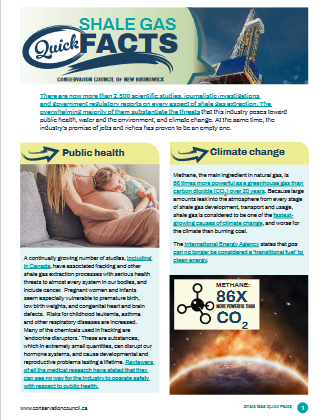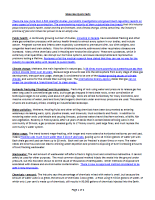Fracturing of rock using water and pressure to release gas has been long used in conventional gas wells, but to get gas trapped in hard shale rocks, a new combination of techniques began to be used in the first decade of 2000. Wells are drilled horizontally for many kilometres, and massive volumes of water, sand and toxic/carcinogenic chemicals under enormous pressures are used. In some areas, thousands of wells are eventually drilled, creating an industrialized landscape.
There are now more than 2,500 scientific studies, journalistic investigations and government regulatory reports on every aspect of shale gas extraction. The overwhelming majority of them substantiate the threats that this industry poses toward public health, water and the environment, and climate change. At the same time, the industry’s promise of jobs and riches has proven to be an empty one.
(Downloadable versions below)
A continually growing number of studies, including in Canada, have associated fracking and other shale gas extraction processes with serious health threats to almost every system in our bodies, and include cancer. Pregnant women and infants seem especially vulnerable to premature birth, low birth weights, and congenital heart and brain defects. Risks for childhood leukemia, asthma and other respiratory diseases are increased. Many of the chemicals used in fracking are ‘endocrine disruptors.’ These are substances, which in extremely small quantities, can disrupt our hormone systems, and cause developmental and reproductive problems lasting a lifetime. Reviewers of all the medical research have stated that they can see no way for the industry to operate safely with respect to public health.
Methane, the main ingredient in natural gas, is 86 times more powerful as a greenhouse gas than carbon dioxide (CO2) over 20 years. Because large amounts leak into the atmosphere from every stage of shale gas development, transport and usage, shale gas is considered to be one of the fastest-growing causes of climate change, and worse for the climate than burning coal. The International Energy Agency states that gas can no longer be considered a ‘transitional fuel’ to clean energy.
Methane, fracking fluids and other drilling chemicals have been documented as entering waterways via leaking wells, spills, pipeline breaks, well blowouts, truck accidents and floods. In addition to rendering water wells undrinkable and causing illnesses, poisoned waters have killed farm animals, wildlife, fish and vegetation. Recently in Pennsylvania, after 13 years of denial that it contaminated drinking wells in the community of Dimock, a gas producer pleaded guilty to 17 felony counts, paid large fines, and must replace the community’s water system.
The trend toward mega-fracking, with longer and more extensive horizontal wellbores per well pad, means fracking uses much more water than it did 15 years ago, gulping up to 100 million litres of water per well. Each shale gas well pad can have up to 20 wells. Each well can be ‘fracked’ a dozen times or more. The water needs are enormous and can lead to drinking water depletion and problems disposing of ever-increasing amounts of toxic fracking wastewater.
Wastewater: The vast amount of wastewater left after a frack is highly toxic and sometimes radioactive. It cannot safely be used for other purposes. The most common disposal method injects the waste into the ground under pressure, but this has been shown to be the cause of thousands of earthquakes. Other methods of disposal are associated with disease and environmental contamination. There is now no approved method considered to be safe in New Brunswick.
Chemicals – amount: The industry says the percentage of chemicals mixed with water is small, but because the amount of water used is so great, the amount of chemicals is also great. A frack using 9 million gallons of water, of which only 1 per cent is made up of chemicals, still results in 90,000 gallons of chemicals injected into the Earth.
Chemicals – health: We have no information whatsoever on the health effects of nearly 80% of the over 1,000 chemicals used in fracking. Of those that have been studied, hundreds are associated with cancer and/or damage to the brain and nervous systems, immune and cardiovascular systems, kidneys, liver, eyes, skin, respiratory tract, gastrointestinal tract and reproductive system. There is no information on how they react when mixed with each other or with naturally-occurring toxic elements in the Earth. Living near a shale gas well is to be a guinea pig in the largest uncontrolled chemical experiment in the world. And the people running it don’t have to tell you the chemicals to which you are being exposed.
Many studies have linked illnesses to how many gas wells are nearby and how close they are to people. Studies have documented problems up to 10 kilometres from wells. Because they can be inhaled, swallowed, and also reach the skin, the potential for exposure to volatile chemicals is greater. Thus, air pollution has emerged as one of the primary public health concerns. Shale gas chemicals have also created record-breaking amounts of ground-level ozone that have been documented as travelling more than 300 km from its source, aggravating asthma, respiratory diseases, and irreparable lung damage.
A single well pad requires thousands of heavy truck trips, operating 24/7. Damage to roads and bridges can reach billions of dollars, and taxpayers are often stuck with a large portion of that bill. The destroyed roads impact everything from emergency vehicles to school buses to normal community life. Traffic accidents and fatalities increase significantly.
The gas industry has never been a source of a lot of permanent jobs, especially when compared to clean energy and energy efficiency industries. The industry has eliminated many jobs through automation, meaning that experienced workers from elsewhere will fill most of the remaining jobs. Locals will get temporary jobs such as truck drivers and security guards. N.B. businesses already have many job openings that they can’t fill. A study of the Marcellus Shale deposit in the eastern United States found that while all rural counties in Pennsylvania experienced population decline during the study period, counties that housed shale operations lost significantly more residents. People don’t want to live near these wells.
Places like Alberta and Saskatchewan already have many tens of thousands of abandoned wells, many of which were not closed down properly or at all, thus continuing to leak methane and toxic air and water. The auditor of Saskatchewan estimates this will cost $4 billion to clean up, while in Alberta the amount may be $48 billion. Nowhere has the industry put aside anywhere near enough money to cover this. It’s likely that the federal government – meaning taxpayers – will have to bear the responsibility for this.
Both the disposal of wastewater and fracking itself have been identified as causing thousands of earthquakes, mostly small, but some large enough to cause property damage and injure people. The earthquakes can continue long after the initial activity is over. Areas close to fault lines are particularly vulnerable and in BC, Canada’s leading seismologist recommends prohibiting fracking within 5 km of hydroelectric dams. Researchers are studying the relationship between fracking and earthquakes, trying to better predict ‘induced seismicity’.
***
The Conservation Council of New Brunswick, in conjunction with NBASGA,
offers (2023) downloadable Quick Facts for sharing in two formats:
 | Full colour with graphics, 5 pages, pdf version. 6.2MB |  | Black and white, no graphics, 2 pages, pdf version. 50KB |
